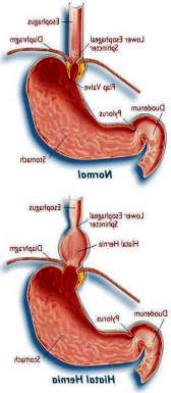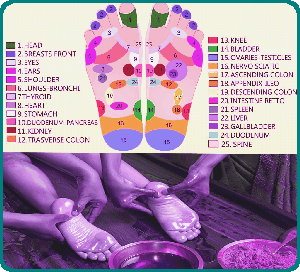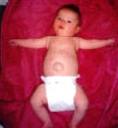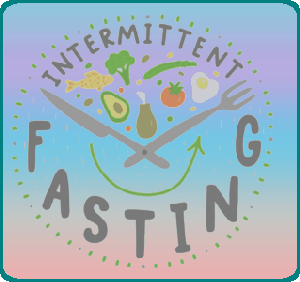
What is a Hiatus Hernia?
Hiatal HerniaIt is the passage of a permanent or intermittent portion of the stomach through the esophageal hiatus (or hiatus) of the diaphragm. This passage of the upper end of the stomach into the hiatus occurs when the fastening means of the stomach and the lower esophagus are failing.
In 90% of cases, there are sliding up the cardia (upper part of the stomach) and leaving the abdomen and is located in the thorax. The causes are such as increased pressure in the abdomen, obesity, congenital shortening of the esophagus.
In 10% of cases there bearing the fundus of the stomach passes through the aperture diaphragm while the lower esophagus and the cardia remain in place. The cause is most often a congenital defect of the hiatus of the diaphragm, it may also be a trauma.
Hiatal hernia is the most common lesions of the gastrointestinal tract.
Signs of the disease
The GERD symptom is the most evocative (burn behind the breastbone) especially if postural (pain increases when increasing the pressure on the abdomen). but other signs may suggest the diagnosis:
- Pain on swallowing (dysphagia esophagitis fears);
- Pain in the pit of the stomach;
- A discrete anemia with pallor and fatigue due to micro-gastrointestinal bleeding;
- Venous thrombosis of the lower limbs (phlebitis);
- Vomiting of blood (hematemesis).
Other violations of the digestive tract are often associated and should be pursued systematically: gallstones, ulcers, gastritis, colonic diverticulosis. Similarly, it is usual to find a hiatal hernia in recent.
Examinations and Tests
Already on chest radiograph and lateral views, the practitioner may sometimes note the absence of gastric air pocket. This is especially the transit oesogastroduodénal (UGI), followed by a fluoroscopy screen, which will show the possible hiatal hernia and gastroesophageal reflux.
Fibroscopy research confirms the diagnosis and complications (esophagitis gastroesophageal reflux).
Treatment
Rules of hygiene and nutrition are the same as those of gastroesophageal reflux :
- Lose weight if overweight;
- Split and food intake rather do 5 or 6 small light meals 2 meals abundant;
- Avoid soft drinks, spices, coffee, fats and alcohol, dressing, fruit acids;
- Avoid foods such as slow-digesting fatty dishes;
- Avoid tobacco;
- Take the evening meal before bed time and avoid napping after lunch;
- Avoid wearing girdles, corsets or belts too tight;
- Elevate the head of the bed;
- Avoid leaning forward posture.
In sliding hernias, surgical treatment is indicated if there is a significant and troublesome reflux despite correct treatment or in case of severe esophagitis.
Rolling hernias are most often made. The intervention consists of a gastropexy (attachment of the fundus of the stomach to the underside of the diaphragm).
Recently Viewed
 Reflexology:
Reflexology:Pressure applied to the feet generates a signal through the peripheral nervous system. From there it enters the central nervous system where it is processed in various Continue Reading →
 Diaphragmatic Hernia CDH:
Diaphragmatic Hernia CDH:Diaphragmatic hernias can be divided into two broad categories: congenital diaphragmatic defects and acquired diaphragmatic defects.In adults this type of Continue Reading →
 Epigastric Hernia:
Epigastric Hernia:An epigastric hernia appears through the abdominal wall, between the bottom of the breastbone and the navel. Both men and women may have this type of Continue Reading →
 Eye Problems:
Eye Problems:The fine skin around your eyes is the first to show the signs of ageing as well as dark circles and puffiness. Don't be tempted to deal with the problem by slapping on Continue Reading →
 Sinus Problems:
Sinus Problems:The most common ailment seen by physicians is what is generally referred to as an upper respiratory infection. In this category are such things as colds blocked stuffy Continue Reading →
Recently Viewed
 Intermittent Fasting:
Intermittent Fasting:Which Intermittent Fasting Plan? 6:8 method,, 5:2 diet, Warrior Diet, Eat Stop Eat, Alternate Day Fasting (ADF) Before we go any further, whilst I think there may be Continue Reading →
 Health Benefits of Coconut Oil:
Health Benefits of Coconut Oil:Coconut oil first appeared in Southeast Asia and the Pacific islands in the mid-nineteenth century. Today the production and export of this oil is part of one of the Continue Reading →
 Colon Hydrotherapy:
Colon Hydrotherapy:Colon Hydrotherapy is an important treatment for a number of health problems including constipation and irritable bowel syndrome. Many believe that for a person to be Continue Reading →
 Marmite for Keto Flu:
Marmite for Keto Flu:I was sorely tempted the title this page 'Marmite for Keto Flu? WTF???' Having lived in the uk for over 60 years I am a big marmite fan. You either love it or hate it. Continue Reading →
 Walking vs Running Calories:
Walking vs Running Calories:In terms of relative calorie burn, running burns roughly 130% more calories than walking. Below is a more accurate calorie burn for running vs walking (the difference Continue Reading →
